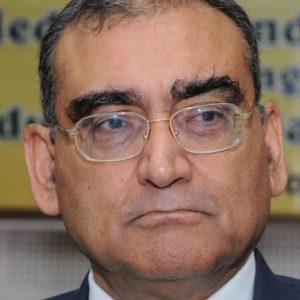

Holi is the festival of colours in India, and marks the end of winter and the advent of spring.
Though Holi is celebrated throughout most of India and even abroad (due to the Indian diaspora), I venture to submit that those who have not seen Braj ki Holi have not seen India.
Braj is the area comprising of Mathura city in the state of UP, India and its surrounding region including places like Vrindavan, Gokul, Govardhan, Barsana, and Nandgaon.
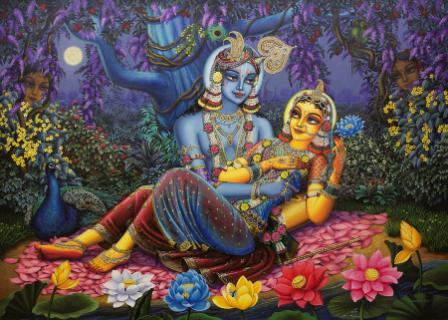 It is associated with the life of Lord Krishna, an important god in the Hindu pantheon. The dialect of Hindi spoken there is called Brajbhaasha in which the great poet Surdas wrote.
It is associated with the life of Lord Krishna, an important god in the Hindu pantheon. The dialect of Hindi spoken there is called Brajbhaasha in which the great poet Surdas wrote.
Braj ki Holi this year has commenced on 28th February, which was ‘Lathmaar Holi’, and will last until ‘Dauji ka Huranga’ on 9th March i.e. a total of 10 days. Holi in particular is on 8th March. During this period of 10 days the whole of Brij region will be full of colour and festivity.
Lathmaar Holi, which marks the commencement of Braj ki Holi, was celebrated on 28th February this year, and takes place every year in Barsaana, which is 40 kms from Mathura city. It is believed to be the home town of Radha, the chief consort of Lord Krishna.
There is a temple of Radha in Barsaana on a hillock, where people of all ages can be seen dancing and singing throughout the day.
In Barsaana people greet each other by saying ‘Radhe, Radhe’ instead of saying ‘Jai Shri Krishna’. That is because Krishna fled to Dwarka (in Gujarat) when King Jarasandh attacked Mathura, thereby abandoning the people of Braj, but Radha remained with them.
 In Lathmaar Holi the young men and boys of Nandgaon, where Krishna spent part of his childhood, walk 9 kms to Barsaana, and are beaten with lathis (sticks) by the women of Barsaana (the young men wear protective headgear to prevent serious injury to their heads, as the beating is usually on the heads).
In Lathmaar Holi the young men and boys of Nandgaon, where Krishna spent part of his childhood, walk 9 kms to Barsaana, and are beaten with lathis (sticks) by the women of Barsaana (the young men wear protective headgear to prevent serious injury to their heads, as the beating is usually on the heads).
Thereafter Holi is celebrated for the next 9 days throughout Brajmandal. Everywhere one goes one will find colour in the air, and people celebrating in various ways. Dramatic performances of Lord Krishna’s ‘Ras Leela’ (love affairs with his gopis) can be seen in many places.
This year’s schedule of Braj ki Holi is given here
Now I may mention something about the important places in Brajmandal.
Mathura city is its centre, and it is believed this is where Lord Krishna was born to his mother Devaki and his father Vasudev who were imprisoned by Devaki’s brother Kansa.

Kansa wanted to kill Krishna, so at night Vasudev carried him secretly to Gokul which was across the river Jamuna, and left him with his foster parents Nand and Yashoda. Later, when he grew up he returned to Mathura, killed Kansa, and became king of Mathura
In Mathura there are many temples of Lord Krishna, the main one being Dwarkadheesh temple.
Vrindavan, about 12 kms from Mathura, is where Lord Krishna is believed to have spent part of his childhood (the other part was in Nandgaon). The most important temple there is Banke Bihari temple, whose priests are not Brahmins, but belong to the Gosain caste.
Other temples there are Radha Raman temple, ISKON temple, etc. There is also a south Indian temple in Vrindavan called Rangji temple, built on the model of the Srirangam temple in Trichy, whose priests are all Tamilians
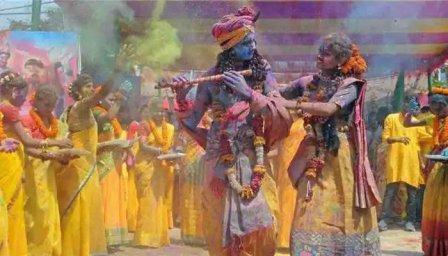 In Gokul, which is across the Jamuna river, is also a Krishna temple, and also a mazaar of the great Hindi poet Raskhan who, though a Muslim, wrote beautiful poetry praising Krishna and the Mathura region.
In Gokul, which is across the Jamuna river, is also a Krishna temple, and also a mazaar of the great Hindi poet Raskhan who, though a Muslim, wrote beautiful poetry praising Krishna and the Mathura region.
Many people perform the 22 km ‘parikrama’ (circumambulation) of Govardhan, which is in the form of a figure 8. I have done the parikrama many times on foot.
Govardhan is the hill which it is believed Lord Krishna lifted on his finger as a sort of umbrella to protect his sakhas ( boyhood friends ) to protect them from the wrath of the rain god Indra. The hill is dilapidated now. There is also a big Krishna temple in Govardhan.
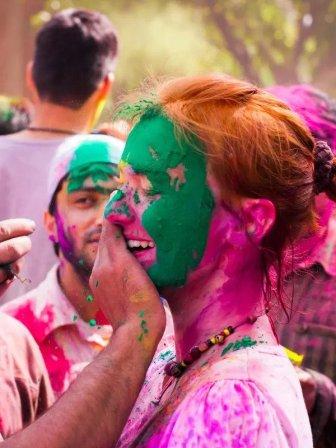
The day before Holi there is Holika Dahan, which will be this year on 7th March. Bonfires are lit up in the night, symbolising the triumph of good and destruction of evil.
Holi proper will be this year on 8th March, when colour will be splashed all around. In the evening ‘sookhi Holi’ or dry Holi is played, by not using wet colours but dry ones, which are applied to people’s faces
The next day, i.e. 9th March, will be ‘Dauji ka Huranga’, which is the culmination of the 10 day long Brij ki Holi (though some regard it longer).
Dauji is Baldau or Balaram, the elder brother of Lord Krishna, and his temple, where this will be celebrated, is about 18 km from Mathura city.
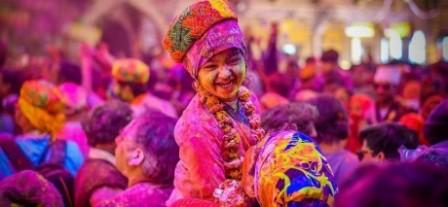
Dauji ka Huranga is held in a square courtyard, surrounded by tall buildings. The spectators sit in the upper storeys of these buildings, while the couryard is flooded with coloured water. The womenfolk then enter the courtyard, tear the upper garments ( usually a dhoti or shirt ) from the bodies of the menfolk gathered there, dip them in the coloured water, and then beat the menfolk with the torn clothes. At the same time colour is thrown all around
Though originating as a Hindu festival, Holi later began to be celebrated by all communities in India, and thus it represents the composite culture (Ganga Jamuna tehzeeb) of India. It was celebrated even by Muslim rulers like the Mughal Emperors, Nawabs of Avadh, etc.There are several paintings of Mughal Emperors celebrating Holi.
Famous Urdu poets like Nazir Akbaradi, Hasrat Mohani wrote beautiful poems on Holi
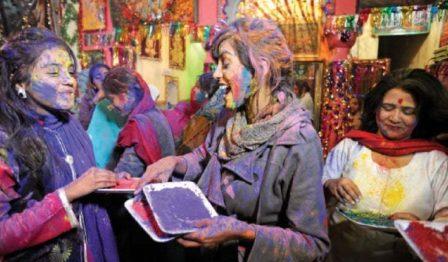 My Pakistani journalist friend Sajjad Azhar Pirzada who lives in Lahore told me that Holi is also celebrated in Pakistan
My Pakistani journalist friend Sajjad Azhar Pirzada who lives in Lahore told me that Holi is also celebrated in Pakistan
Holi is celebrated by the Indian diaspora all over the world. My friend Shaista Ali and her husband Syed Ali, who live in California, USA organised a Holi celebration at their residence, which I attended.
Happy Holi to all! ![]()
___________
Also Read:
TRUTH VS FALSEHOOD: BBC – Who is afraid?
Mughal Gardens – Name Changed, But Why?
Industrialization versus Environmental Degradation
Punjab – How a deadly cocktail of Agri-Water-Energy nexus going to destroy it?

Disclaimer : PunjabTodayTV.com and other platforms of the Punjab Today group strive to include views and opinions from across the entire spectrum, but by no means do we agree with everything we publish. Our efforts and editorial choices consistently underscore our authors’ right to the freedom of speech. However, it should be clear to all readers that individual authors are responsible for the information, ideas or opinions in their articles, and very often, these do not reflect the views of PunjabTodayTV.com or other platforms of the group. Punjab Today does not assume any responsibility or liability for the views of authors whose work appears here.
Punjab Today believes in serious, engaging, narrative journalism at a time when mainstream media houses seem to have given up on long-form writing and news television has blurred or altogether erased the lines between news and slapstick entertainment. We at Punjab Today believe that readers such as yourself appreciate cerebral journalism, and would like you to hold us against the best international industry standards. Brickbats are welcome even more than bouquets, though an occasional pat on the back is always encouraging. Good journalism can be a lifeline in these uncertain times worldwide. You can support us in myriad ways. To begin with, by spreading word about us and forwarding this reportage. Stay engaged.
— Team PT


Copyright © Punjab Today TV : All right Reserve 2016 - 2024 |